Ever wondered why some young children seem to spend a huge amount of time and effort in placing objects in a line side by side?
It’s called a positioning schema, and it’s a very common behavior that you will see often.
A positioning schema is when a child is interested in experimenting with order and sequence and will place objects next to each other in some form of alignment.
Children that do this are fascinated by classification, shape, symmetry, and order.
In this post, I’ll describe what a positioning schema is, and also the many things you can try out that will support this learning behavior.
Supporting and encouraging schemas in play is really beneficial, and will increase the depth and intensity of a child’s learning.
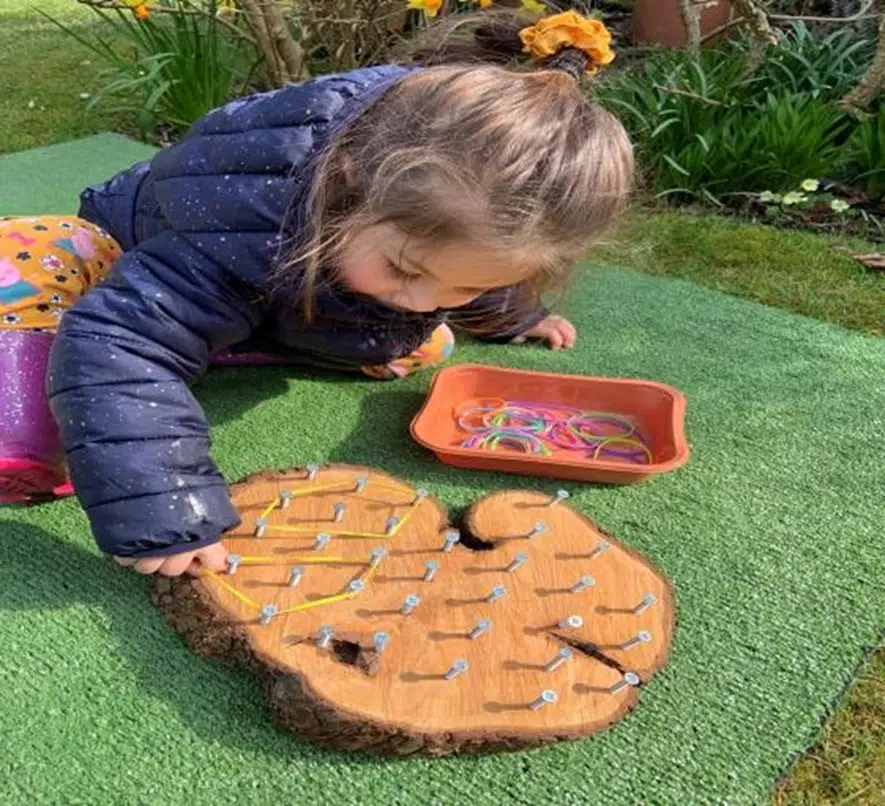
What Is A Schema?
A schema is a repeated pattern of behavior. It is a type of repetitive play that children use to test reality and create models and ideas in their minds. (Source)
For example, if a child is fascinated by moving objects like stones and leaves around the outdoors, using buckets and trolleys, then they may well be exhibiting a transportation schema.
Likewise, if they enjoy sitting upside down, or looking at toy cars with their heads flat on the floor, then they may well have an orientation schema.
Schemas allow children to explore their ideas and thoughts.
They let them test reality, and express their thinking. (Source)
Supporting Schemas
Schemas are important not merely from a technical and theoretical perspective.
By understanding and supporting schemas, we help children to become more engaged, more curious, and ultimately to learn at a faster rate.
That is why supporting schemas is so important! It has real-world results that can be very powerful.
When supported, schemas help children to flourish, think, and make excellent progress.
For example, if a child is fascinated by windmills and glitter balls, they may well be demonstrating a rotation schema. By simply adding objects like spoons and whisks to the outdoor learning space, they may find a rich source of play in stirring and whisking puddles, sand, mud, and any other substances they find.
Another example might be a child that is interested in being upside down or viewing the world a different way (an orientation schema). By adding opportunities like tunnels to crawl through or a tire swing, this schema can be supported, and the quality of learning deepened.
What Is A Positioning Schema?
A positioning schema is when a child is interested in placing objects in an alignment of some sort.
They are learning about order, and how this translates to objects around them.
They are also interested in sequences and symmetry.
You will often observe the following things:
A child will put lots of toys in a long line.
They will repeat patterns of objects alongside and on top of one another. For example, they will create a long line of wooden blocks. Then they will put an object on top of each block in turn.
Many children will put a favorite toy in a line repeatedly. Often this is things like toy cars.
22 Activities That Support An Orientation Schema
There are many simple resources you can give children access to that will result in this type of schema being supported.
Here is a range of simple ideas that you can try:
1. Mandalas
These are beautiful symmetrical patterns of objects or colors.
Use loose parts such as gems or colored stones. The children arrange them in lines, spirals, or circles.
A nice way to support mandala construction is to draw a simple line template on a big surface such as wallpaper.
Draw a large spiral or a large star shape, and the children place colored gems or other similar items onto the template.
This provides simple structure, while still allowing them to experiment with sequence and color.
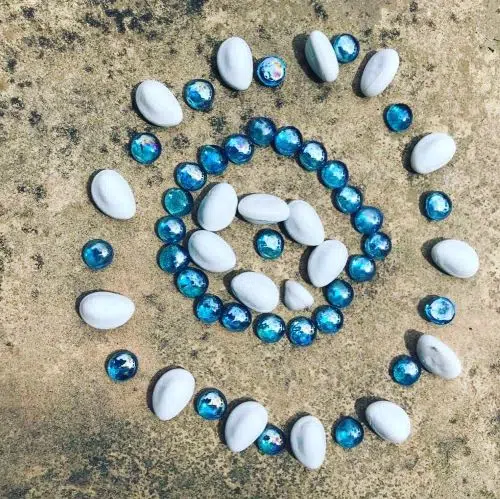
2. Number Stones
I have a wide variety of number stones that I use. They are simply pebbles, painted in a variety of ways.
For example, I have some that are painted like patterned animals:
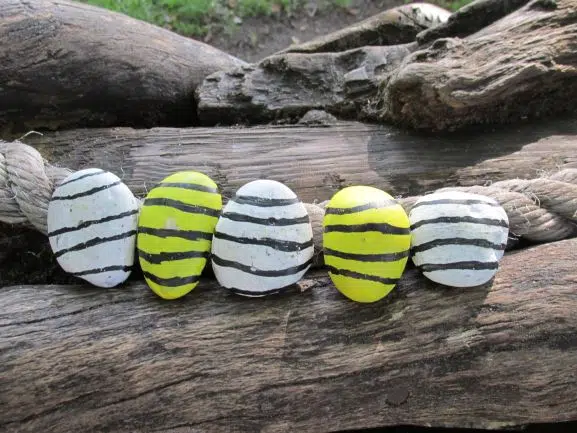
These are great for placing in lines or even making patterns.
3. Small Loose Parts In Trays
If I had to do just one thing on this list, it would be this.
Get a selection of small loose parts in a tinker tray. Something like what you see in this picture would work brilliantly:
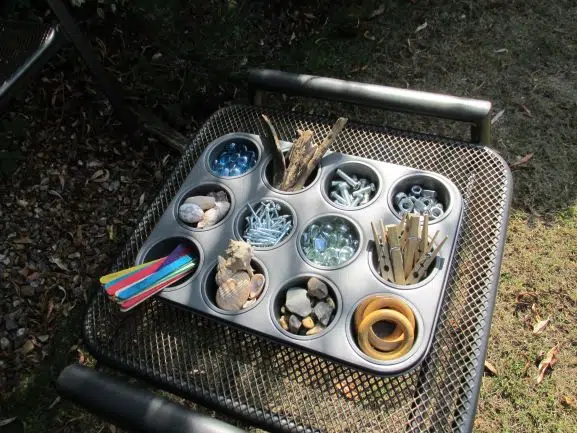
Simply leaving this out in a range of learning spaces will positional schema play.
Children can:
- Create transient art
- Add loose parts to their constructions
- Add loose parts to small world play – for example, creating a path for a character to walk down (maybe a line of gems, for example)
There are a few more ideas over the rest of the post that utilize loose parts such as these.
4. Natural Geo Boards
This is an activity that is great for both fine motor, and for exploring a positional schema.
The geoboards that I use myself look a bit like this:
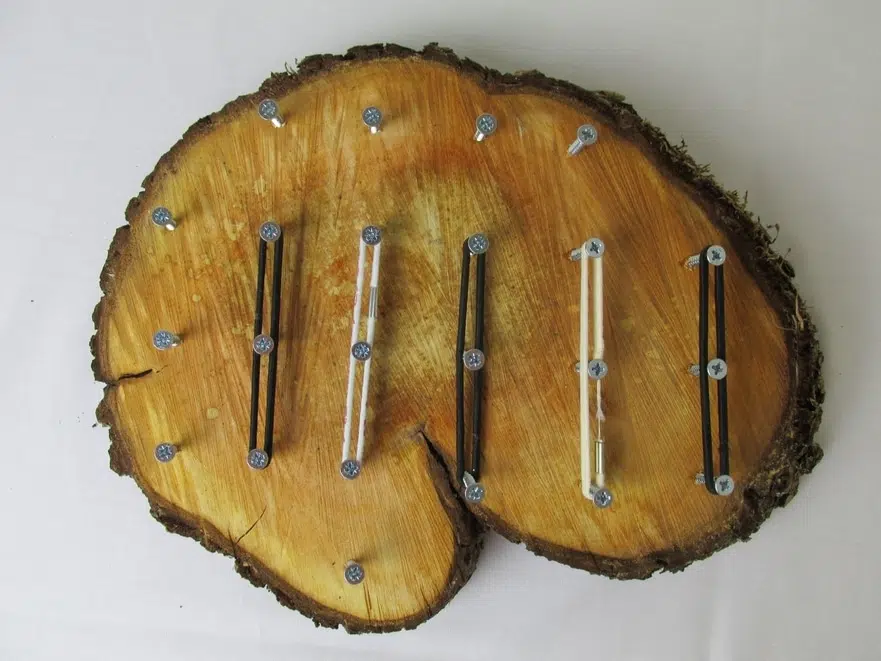
I use log slices and have inserted lines of screws into them.
Children can potentially make their own by hammering small nails into a soft board such as cork (please supervise them one to one if you do this, and use goggles).
For the geoboards, use things like hair bobbles or rubber bands to wrap around the screws.
This works brilliantly for positional schemas as it is all about creating sequences of patterns and colors.
5. Counting and Sorting Natural Objects
Having a range of simple trays of different kinds is great for this kind of schema.
I used to have a wooden tray that had about forty sections. It had been used in a previous life for embroidery equipment.
This was a great frame for providing children the opportunity to place small loose parts into the different compartments.
Some board games or children’s toys come in compartmentalized boxes. Recycle any of these that you can for this kind of natural sorting tray activity.
6. Screws and Nails
Simple hammering activities, like bashing golf tees into pumpkins are good for this kind of schema.
You can also hammer pins into cork-boards.
Simple hand-held screwdrivers can help children turn screws into boards.
For any hammering activities, I would get the children to wear goggles, and supervise them one to one.
7. Natural Number Lines
As an introduction to number lines, I like to use simple planks with lines on in my classroom.
These are great for children to arrange all sorts of natural objects such as stones and leaves in lines.
This lays the groundwork for number sequences on number lines, as well as being great for supporting positional schemas.
8. Creating Plaques With Clay Or Mud
Create simple circular plaques using clay or mud.
The children use a range of simple objects to align on the plaques, for example like these shells:
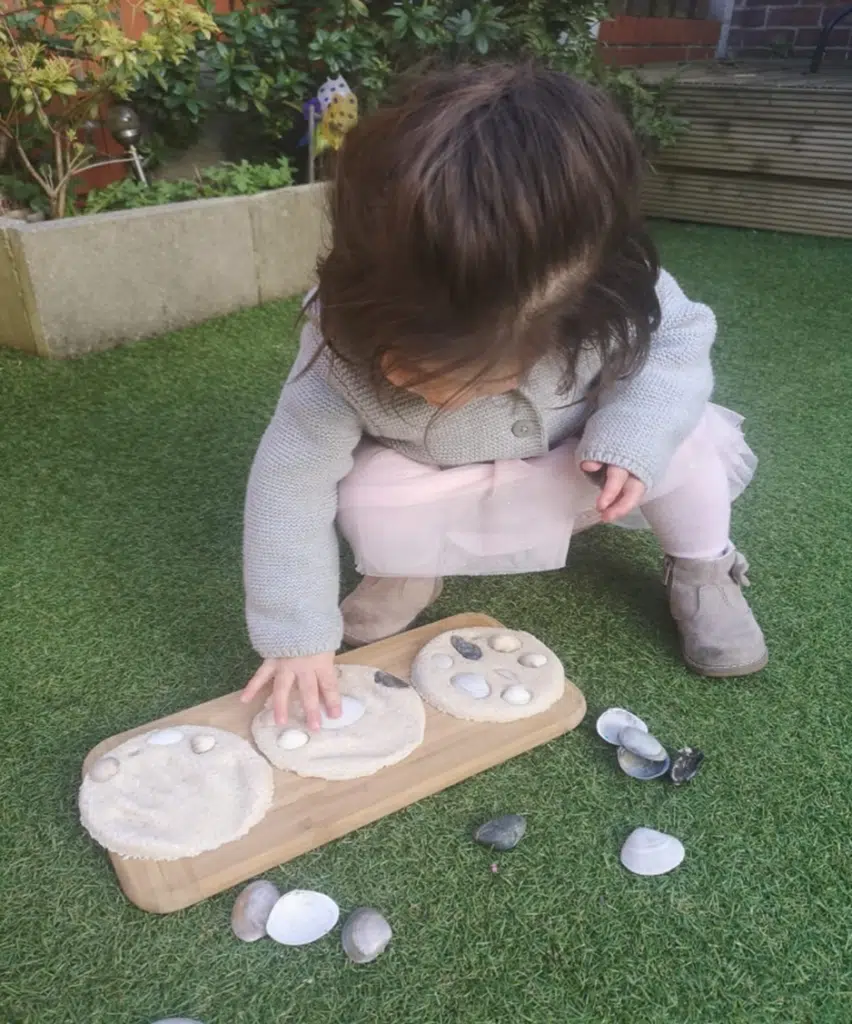
9. Large Ropes On The Floor
Large ropes can be bent into different shapes and patterns.
Children can attempt to build shapes.
Or ropes can be used to create trails. Often you will see children put skipping ropes in a line.
They can use these as a balance beam, or as a trail.
10. Mirror Books With Natural Objects
This is one of my favorite loose parts activities.
Get two safety mirrors and tape them together so that they form a ‘book’.
Now place them so that they are facing up on a surface. Children can place a range of loose parts inside the two faces of the mirror book.
This creates a beautiful pattern to form in the mirrors, just like this:
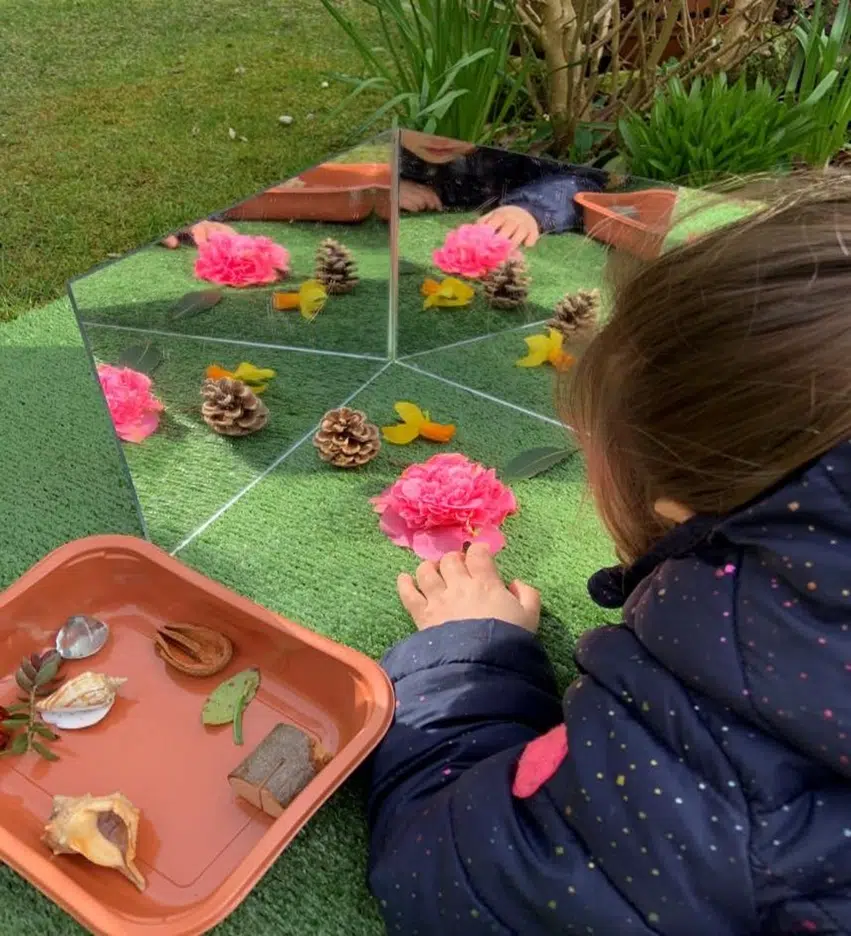
This is great for positioning, and placing objects side by side, and watching the beautiful visual effects that result from it.
11. Scavenger Hunts
A simple scavenger hunt collecting similar objects is good for this kind of schema.
Have a piece of card, with sticky back plastic on it. Each child will have one of these, and they go around the environment searching for objects, for example, leaves.
When they find leaves, they place them in a line on the sticky back plastic.
This creates a beautiful alignment and helps them to really focus on the differences and similarities between leaves.
12. Threading Leaves Onto Skewers
Another leaf activity is leaf jewelry on kebab sticks or skewers.
This is best done as a sit-down activity to avoid injuries with the skewer or kebab stick.
Have a range of leaves, and pierce them on the skewer or kebab stick one at a time, creating a leaf kebab.
13. Looking At Reflections In Water
Many children with a positioning schema will notice these reflections already. But you can also support those that don’t by drawing attention to them.
You can talk about the reflections in:
-Puddles
-A Water tray
-A pond or lake
-The sea
14. Threading Jewelry Such As With Pasta
This is a really old-school activity that lots of children with a positioning schema really enjoy.
Have long pieces of string or cotton wool, and thread beads or pasta onto the material. You can first paint or color the pasta in some way.
15. Ten Frames
Ten frames are a really powerful structure to support early math, and they are great for positional schemas.
A ten frame is simply a grid of ten boxes, in the form of two rows of five.
You can paint them onto logs, or material, or create them in a whole host of ways. Here is one I painted onto a piece of wood:
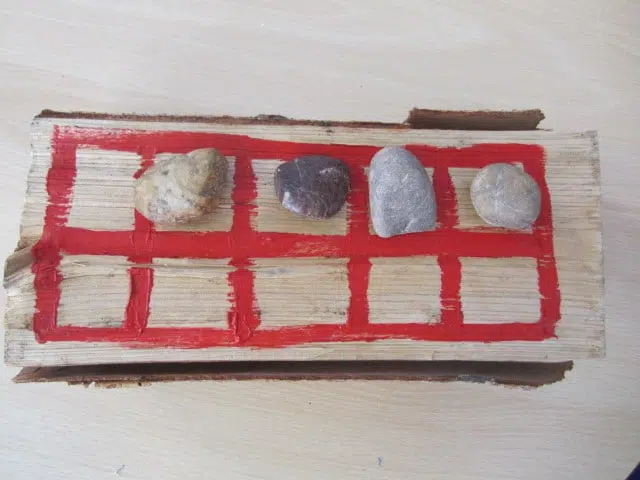
Children arrange loose part objects onto the ten frames. These are a beautiful way of exploring numbers in the context of ten.
You can also explore:
- Patterns
- Adding
- Counting
- Ordering
- Number bonds
- Subtraction
16. Egg Boxes
These are so simple, but just provide some of these, alongside some loos parts, and children will fill them with all sorts of sequences and patterns.
17. Toy Stairs
I have seen positional schema play often around toy stairs.
You might find these stairs in doll’s houses.
What I have found is that children love to arrange things on these stairs. It might be gems, or clothes, or whatever is in the doll’s house.
They also create stairs as part of their construction play.
Once again, having a range of different construction toys will provide them an opportunity to place different objects on the stairs that they create.
18. Parking Lots
One of the most common times that you will see a positioning schema is in a child that is interested in cars and parking lots.
Some children will create a car park spontaneously by lining up cars on the floor, but some can be supported by the adult creating a parking lot.
You can easily make one by simply getting a large surface, such as wallpaper on the floor, and drawing a sequence of rectangles next to each other.
A simple frame such as this can stimulate a huge amount of positioning play.
19. Construction In General
Wherever there are children playing with construction toys, you will see positioning schemas in action.
You will see lines of blocks both horizontal and vertical.
There will be lines of objects on top of other lines, or next to them.
Simply having a range of construction toy opportunities both inside and outside (if possible), will lead to lots of good quality positioning schema play.
20. Train Tracks
Train-play is another one that lends itself well to positioning schemas.
Building train tracks is a simple activity that supports this.
Also aligning any other objects next to the track, be they toys or loose parts, also encourages this type of schema.
Tracks can be drawn on paper or cardboard boxes, as well as simply using wooden or plastic train-track sets.
Positioning Schemas And Autism
As a teacher, several parents that I have spoken to in the past have been concerned that their child’s enjoyment of lining up toys could be a sign of autism.
I have always said that this is very rarely the case.
It is confusing that some of the most common play schemas are also signs of autism.
A positioning schema is definitely one of these particular schemas
Two things are true:
- A positioning schema is really common, and a large number of children show this interest. Very few of these will ever go on to be diagnosed with autism.
- On the other hand, lining up toys and objects repeatedly is a key sign of autism.
What is most important is how many other signs of autism are present.
If a child is showing many signs of autism for their particular age, then it is probably best to refer them to a medical professional.
However, (and this is the case in most circumstances) if the positioning schema is an isolated feature, or if there are very few other signs of autism present, then it is certainly just what it appears to be…a positioning schema.
A huge number of children learn this way, and will at some point ‘grow out of it’.
Positioning Schema Final Thoughts
- Support positioning schemas by giving access to a range of interesting loose parts and objects
- Unlike some other schemas (for example transportation schemas), positioning schemas usually present no issues in the classroom. They are a focussed and precise form of play, and offer no issues to those around them.
Good luck supporting positioning schemas where you find them!

Anna
Sunday 1st of October 2023
This is so very helpful, thanks a lot!